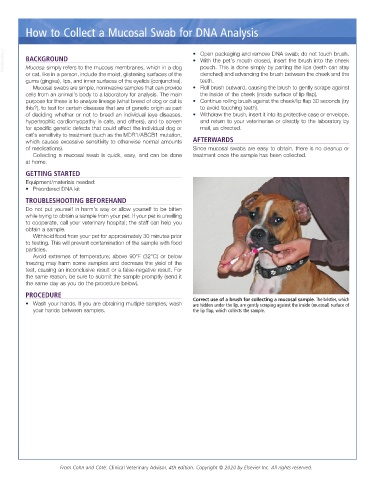Page 3189 - Cote clinical veterinary advisor dogs and cats 4th
P. 3189
How to Collect a Mucosal Swab for DNA Analysis
VetBooks.ir BACKGROUND • Open packaging and remove DNA swab; do not touch brush.
• With the pet’s mouth closed, insert the brush into the cheek
pouch. This is done simply by parting the lips (teeth can stay
Mucosa simply refers to the mucous membranes, which in a dog
or cat, like in a person, include the moist, glistening surfaces of the clenched) and advancing the brush between the cheek and the
gums (gingiva), lips, and inner surfaces of the eyelids (conjunctiva). teeth.
Mucosal swabs are simple, noninvasive samples that can provide • Roll brush outward, causing the brush to gently scrape against
cells from an animal’s body to a laboratory for analysis. The main the inside of the cheek (inside surface of lip flap).
purpose for these is to analyze lineage (what breed of dog or cat is • Continue rolling brush against the cheek/lip flap 30 seconds (try
this?), to test for certain diseases that are of genetic origin as part to avoid touching teeth).
of deciding whether or not to breed an individual (eye diseases, • Withdraw the brush, insert it into its protective case or envelope,
hypertrophic cardiomyopathy in cats, and others), and to screen and return to your veterinarian or directly to the laboratory by
for specific genetic defects that could affect the individual dog or mail, as directed.
cat’s sensitivity to treatment (such as the MDR1/ABCB1 mutation,
which causes excessive sensitivity to otherwise normal amounts AFTERWARDS
of medications). Since mucosal swabs are easy to obtain, there is no cleanup or
Collecting a mucosal swab is quick, easy, and can be done treatment once the sample has been collected.
at home.
GETTING STARTED
Equipment/materials needed:
• Preordered DNA kit
TROUBLESHOOTING BEFOREHAND
Do not put yourself in harm’s way or allow yourself to be bitten
while trying to obtain a sample from your pet. If your pet is unwilling
to cooperate, call your veterinary hospital; the staff can help you
obtain a sample.
Withhold food from your pet for approximately 30 minutes prior
to testing. This will prevent contamination of the sample with food
particles.
Avoid extremes of temperature; above 90°F (32°C) or below
freezing may harm some samples and decrease the yield of the
test, causing an inconclusive result or a false-negative result. For
the same reason, be sure to submit the sample promptly (send it
the same day as you do the procedure below).
PROCEDURE
• Wash your hands. If you are obtaining multiple samples, wash Correct use of a brush for collecting a mucosal sample. The bristles, which
are hidden under the lip, are gently scraping against the inside (mucosal) surface of
your hands between samples. the lip flap, which collects the sample.
From Cohn and Côté: Clinical Veterinary Advisor, 4th edition. Copyright © 2020 by Elsevier Inc. All rights reserved.

